What is Black Hat SEO?
Black hat SEO is a process to get higher search rankings by breaking search engine rules and guidelines. These aggressive black hat SEO techniques and tactics focus only on search engine ranking and are not helpful for the users. Using these SEO strategies may end in a ban in the search engines.
Black Hat SEO Techniques
Some of the famous examples of black hat SEO techniques include keyword stuffing, hidden text, doorway pages, cloaking, webspam, adding similar types keywords to the web page, page swapping and link farming.
This black hat SEO case study focuses on the pharma SERPS once again, in particular the erectile dysfunction Viagra SERPS. This case study is being done a day after Google announced the rolling out of the Penguin 4.0 update. The Google Penguin 4.0 update is a big news story in the SEO world as Penguin is now part of the core Google algorithm. There has been a lot of talk about the upcoming and now live Rolling Penguin update because it means that Penguin is now continuously updating minute by minute, second by second. There has been much speculation about how big of an effect this update would have and some have been speculating that there could be dramatic movement in the SERPS. Indeed, the SERPS (search engine results pages) have been volatile since early September and now everyone’s suspicions that Google was rolling out an update are confirmed.
Given that this is the day after the big Penguin 4.0 update, I figured it would be an especially interesting time to look at the most notorious black hat SEO niche online: the buy Viagra SERPS. I went to Google and search “buy viagra” (no quotes) and the following screenshot is what came up.
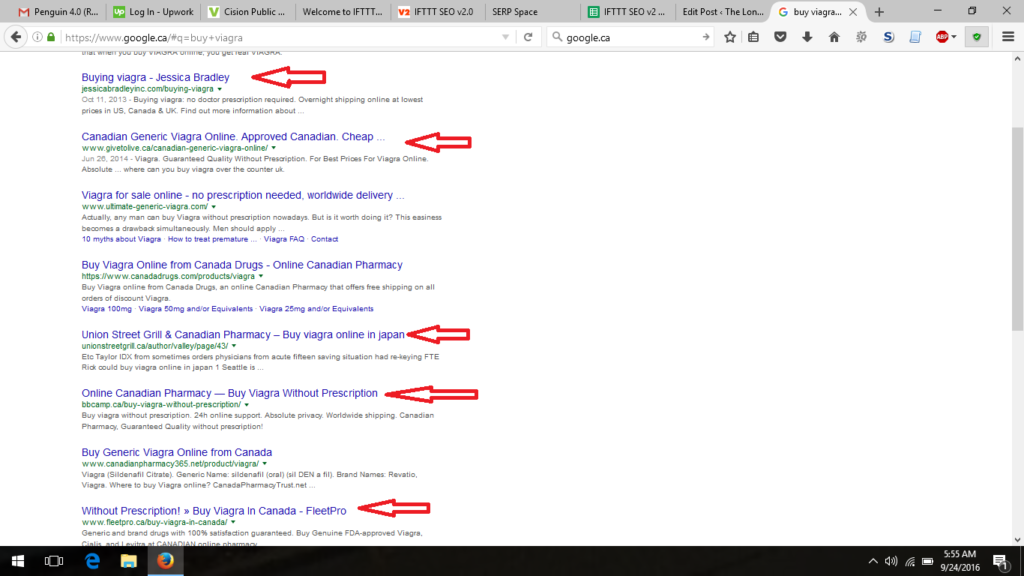
This screenshot taken at about 6:00 AM shows that 5 of 10 results (red arrows are pointing to them) are hacked sites that have taken over by black hat SEO hackers to promote their Viagra products. As a matter of fact, as of the time I’m writing this post at 6:00 PM on the same day, I see a double listing for one of these sites, making it 6 out of 10 results that are the products of black hat SEO. All of this the day after the big Penguin 4.0 update. This is evidence that black hat SEO is still here and still working despite all of the advances made with Google’s various updates like Panda and Penguin. Black hat SEO techniques in 2014 and 2015 were largely the same as they are now. In fact, black hat techniques have been largely the same going way back even to 2007 and 2008. Sites with trust and authority are hacked and “link spammed” to achieve predicable results.
It must be embarrassing for Google to know that the whole SEO community keeps a careful eye on the buy Viagra SERPS, knowing full well that it is the target of SEO spam (I use this term reluctantly because spam is a very specific, very illegal thing, and black hat SEO is not illegal. I will explain more later in this post) yet black hats flagrantly exploit the algorithm nonetheless, and with success. It seems that some things don’t change. Metrics like site trust and authority are valuable assets for those looking to garner quick rankings. It goes to show just how much of a role trust plays in the ranking algorithm. Aggressive link building is still a major necessary factor as well. Let’s have a look the site ranking at position #2 and check out some of the metrics from Ahrefs. The site is http://jessicabradleyinc.com/ which has been compromised and link spammed.
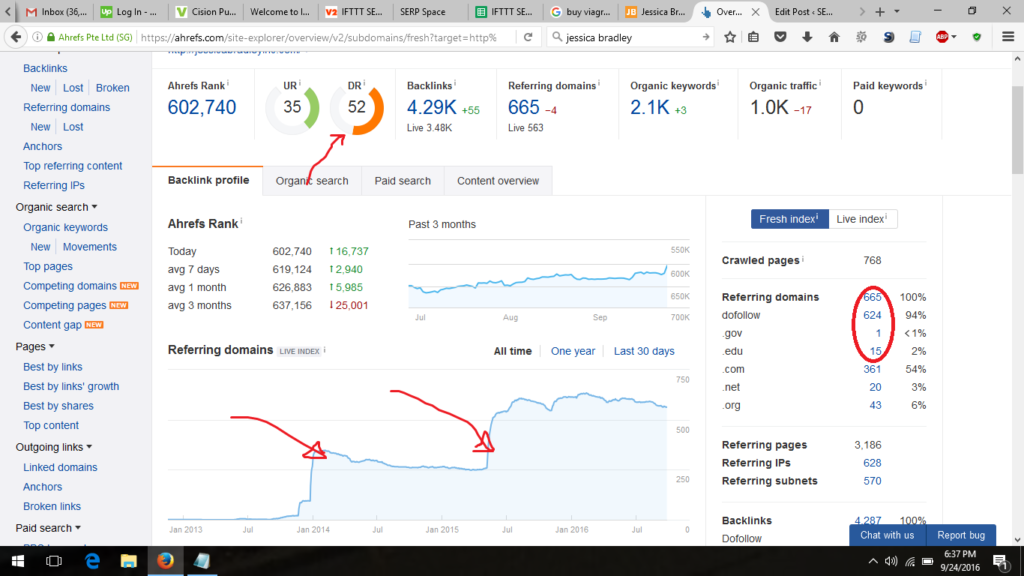
This screenshot shows that the DR (domain rank, which something of a substitute for page rank) is 52, which indicates the site has good authority. Generally, in most of these examples, we see sites with a domain rank of 50 or higher. The graph shows that the number of referring domains suddenly jumped in January 2014 and again in about June 2015. We can see that out of 665 total referring domains 624 of them are dofollow. Dofollow links pass authority and trust from one domain to another whereas nofollow links do not. If we want to rank a site on page one for a given keyword, it’s going to need dofollow links. Many SEOs nowadays are saying that we need a link profile that has lots of nofollow links because that makes it look more natural. Stacking up too many dofollow links clearly shows an attempt to manipulate the search engine rankings. Indeed, such link building strategies are not long term and may only allow a site to rank anywhere from a few hours to a few months. Gone are the days when sites with these kinds of link profiles could rank for years. However, this is not the strategy that black hat SEOs employ. They know that these rankings are short lived so they have a bunch of sites, sometimes hacked sites, sitting in the queue. When their current ranking site goes down, they fire up the next one. This is called churn and burn.
You’ll notice that this site is getting .gov and .edu links, both of which carry a lot of trust and authority. Black hat SEO techniques frequently involve high velocity link building with as many high-trust and authority links as possible, knowing full well that it will be a churn and burn campaign. The idea is to rank for highly trafficked, highly converting keywords. Rank and bank. Let’s have a look now at some of the recent links that have been built and what their anchor texts are.
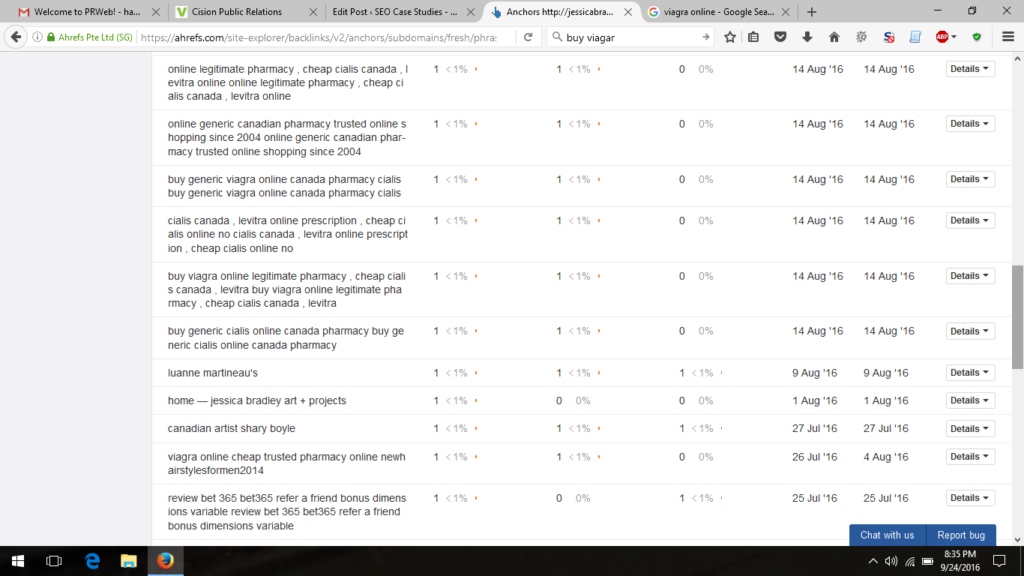
In the first column we see the regular black hat method of being very greedy with the anchor texts. Cialis Canada, levitra online prescription, cheap cialis online, buy viagra online legitimate pharmacy – all of these keywords are stuffed in the anchor text. One would think that this wouldn’t be effective but actually it is. This site ranks for cialis, levitra and viagra. It won’t rank for long, and as a matter of fact the SERPS have already changed as I’ve written this post. A quick check of the buy Viagra SERPS right now shows that there is only one black hat SEO page ranking, and it’s not one of the ones that I screen captured for this post. Of course, these pages could reappear in the SERPS later tonight or tomorrow and then vanish again. Google does do manual removal now, so that plays a part in sudden cleanups like this. Keep in mind that black hat SEO is used in all kinds of niches, many of which most of us have never even heard of. Google can’t keep their eye on everything, manually that is. The Viagra SERPS are different because they are well known and notorious. Returning back to the screenshot above, the column on the right shows that these links were first seen in September and August, so they are part of the latest campaign, hence the sudden rise to the page one. It looks like this latest campaign was started around June or so.
Black Hat On-Page SEO
Once a hacker gets control of your site, he can create pages and promote his products. In the following screenshot, we see that this hacker has created a new page at jessicabradley.com/buying-viagra. It’s a pharmacy landing page as usual.
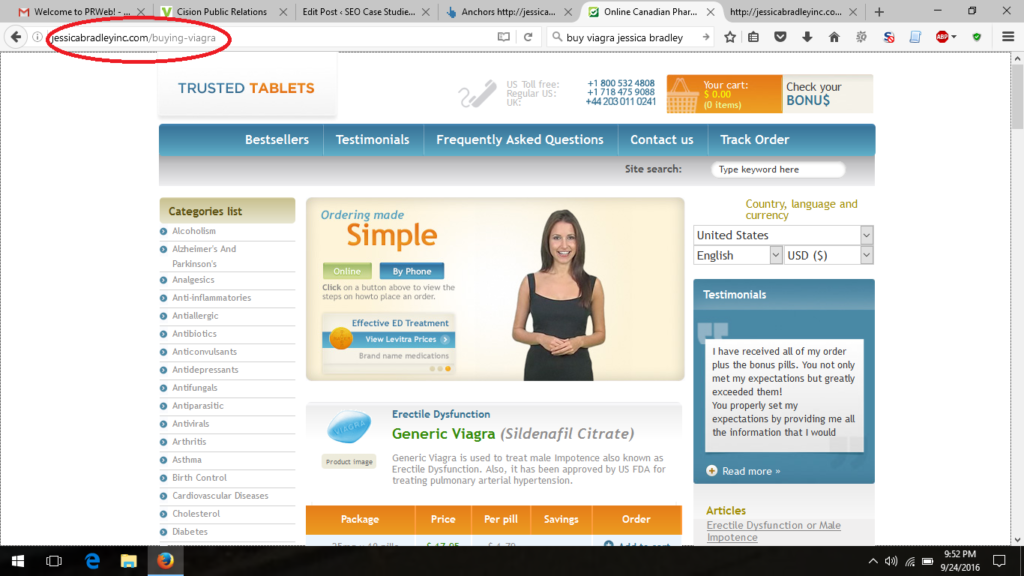
This is how the page looks with java turned on, but if you turn java off you see a Page Not Found page. This is because the content is being delivered by javascript in the following code:
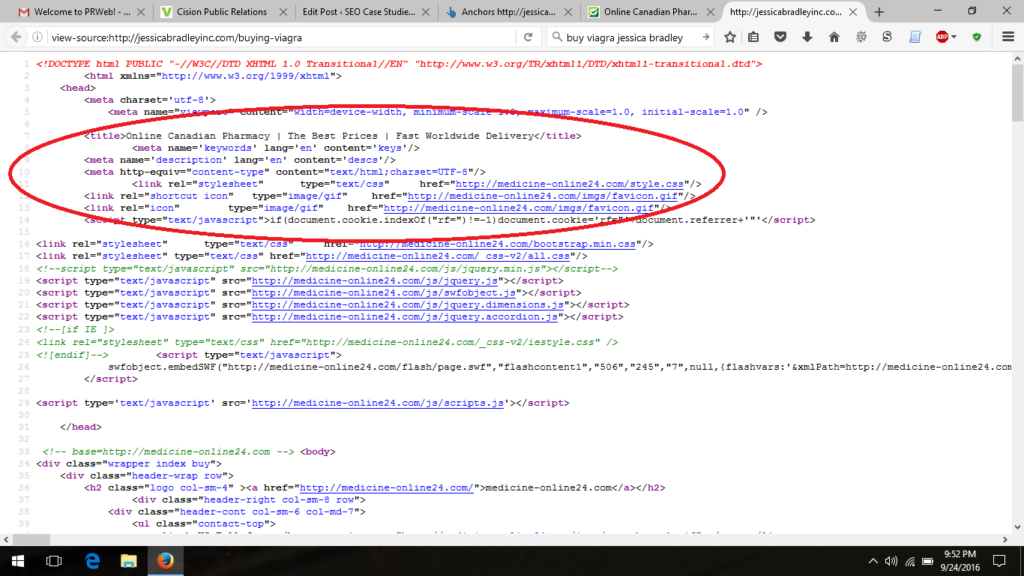
Is black hat SEO illegal?
Black hat SEO is not illegal but hacking is illegal. The two aren’t the same thing. Hacking is compromising someone elses website by breaking into it. That is not legal but that is not SEO either. Black hat SEO is what is done to promote a site, namely, link building. In order to do black hat link building you don’t have to hack other websites. You can just conduct high velocity link building campaigns and stack up anchored links. It’s true that some people that employ black hat SEO methods do in fact hack other sites to host their content (as in this case) as well as to place their links for ranking purposes, but hacking is not SEO. It’s hacking done for SEO purposes.
Is black hat SEO spam?
It’s very common for those in the SEO community to refer to black hat SEO as spam. But this is not the case. True, that word was used in this very article but only with a disclaimer and hesitantly. I used it because others that may read this post will find such usage acceptable and intelligible but it’s actually inaccurate. Spam is a very specific illegal activity. It is the sending of unsolicited email for commercial purposes. That includes promoting web sites, offers and business opportunities, as well as gambling, porn and pills. Creating backlinks is not spam, plain and simple. Spam is a word that has been used by the SEO community in an attempt to dictate the narrative around SEO discussions. White hat SEO professionals were unhappy that they were being one upped by black hat SEOs with low quality websites. Couple that with Google’s loose use of the word SPAM to describe SEO methods that are outside of their preferred guidelines and that sort of cemented the word into the SEO lexicon. They’ve branded black hat SEO as spam, successfully. This scares people into thinking that maybe black hat SEO is illegal. It creates a stigma around black hat SEO methods and techniques, a stigma that deters people from employing such methods. Google doesn’t want their SERPS being manipulated by anybody because they feel that the user experience will suffer. Google feels that they are providing the best content and results for a given search and they don’t want to have their SERPS polluted with all kinds of low quality results, which could be the case.
Black Hat SEO Techniques – Hidden Text and Hidden Links
In order to make sure that the lifetime of a link is maximized, black hat SEOs often hide them by various means and methods. Sometimes they hide them by cloaking the page and sometimes they hide them with negative pixels. I decided to visit one of the linking pages that were showing in Ahrefs and came across http://coto-lifestyle.com/blog/2015/02/14/tap-chi-mon-ngon-viet-nam-xuan-2015/
The anchor is “free viagra without prescription” but it doesn’t appear anyone on the page.
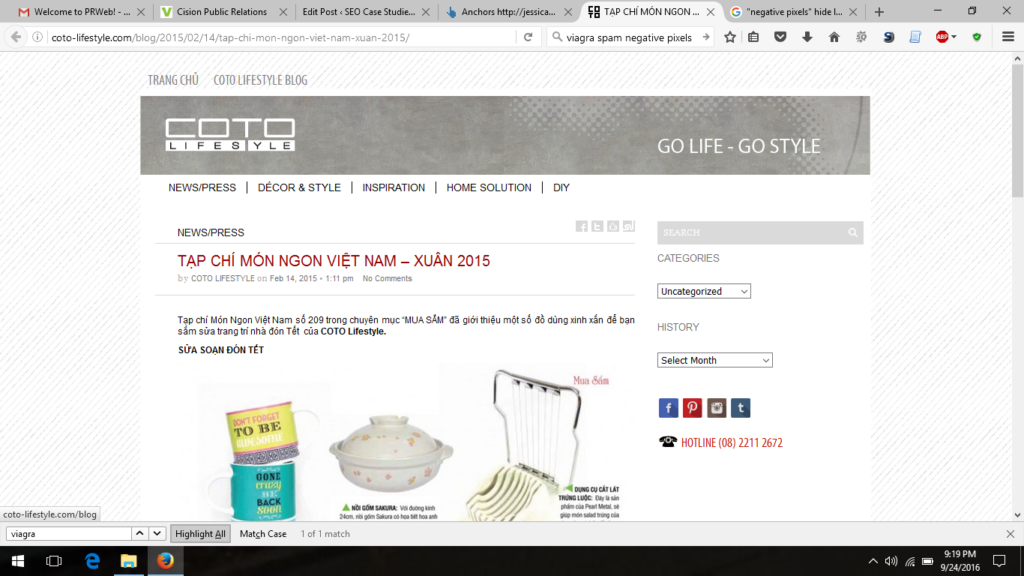
This page looks clean even though when we do a control+f it shows that the word viagra is somewhere on this page. You’d never see it with the naked eye but it’s there. We don’t know if the black hat SEO owns this domain or if he just hacked it but either way it makes sense to hide the link. So how can we see the link? As usual, when we look at the page source we see what is really going on.
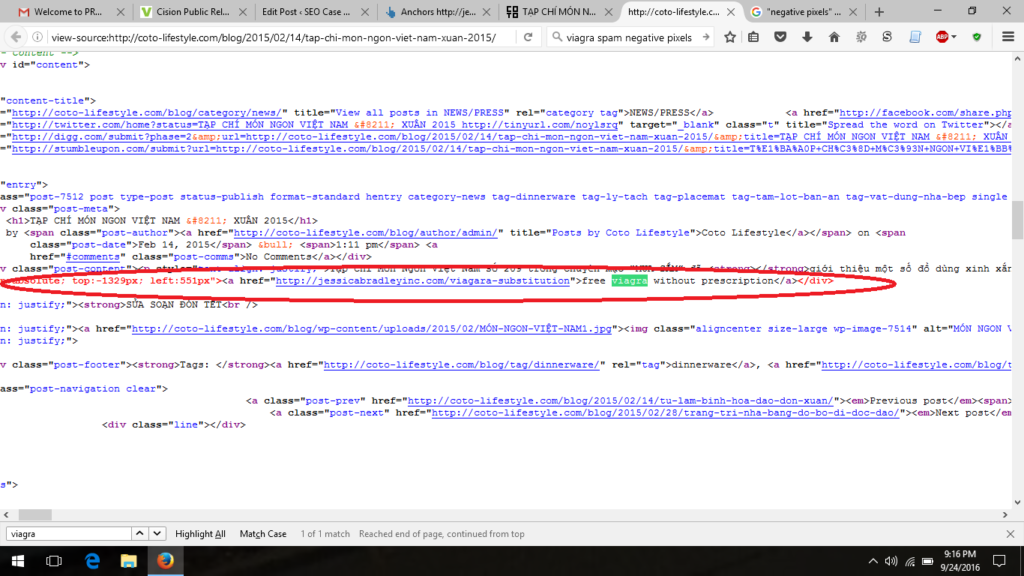
In the circled section of the code we can see, on the far left, a negative pixel value of top:-1329px. Then we see our hacked host’s page (jessicabradleyinc) and the anchor text we were looking for, “free viagra without prescription”. This is all too typical and entirely predictable. Sites with some authority and trust (this one has a domain rank of 42 which is pretty good) are used to place links to obtain fast ranking results and the links are hidden so that they aren’t removed. These kinds of techniques are not done with black hat SEO software but probably with hacking software. First they scan the web for vulnerable websites that are hackable. Then they place the links. Some black hats may write their own scripts to perform this kind of link building but the black hat SEO software that is sold to the general public doesn’t come equipped to place hack-style links. Most black hat SEO software has a certain number of types of platforms (blog comments, forum posts, profile creation, bookmarks, web2.0 creation) that it understands how to submit to and place links. Scrapebox, GSA and Xrumer come to mind right away and none of these are used for hacking and link placement.
It’s important to separate the hacking methods from the SEO. Hacking can be used for SEO but no more so than your laptop can be used for SEO. We need to make sure we do not assign illegality to black hat SEO methods and techniques. The only thing that makes them black hat is Google’s definition, and keep in mind that Google doesn’t produce content – they scrape it (!) which is a so-called black hat technique. Companies are always competing and Google is one company while SEOs are part of other companies. Each has their own goal which is to make money. Google doesn’t get to decide what is moral and what is not for the rest of us, so the idea that black hat SEO is somehow immoral is a little bit ridiculous, but this ethical discussion goes beyond the scope of this black hat SEO case study.
So what can we learn from this case study? We see that